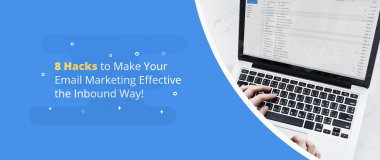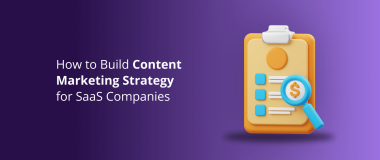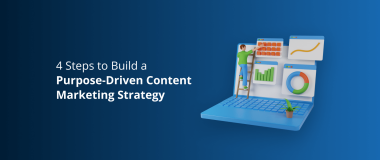Marketing nowadays is an iterative process driven by data. It’s not enough to promote your content but it can reach the people that are interested in it, the audience whose intent is aligned with your business.
Just think of the products that are hyped nowadays. All of them are personalized to fit the requirements of users – from Facebook displaying the viewers’ social circle and lifestyle in the newsfeed, to Spotify playing songs based on users musical interests, and Google displaying search results based on user intent.
To be able to facilitate real results through marketing you have to use the power of data to understand your users and their intent.
Intent-Based Marketing
This marketing technique focuses on delivering the right content, at the right time, to the people who are marketing- and sales-qualified leads. It’s an incredibly effective way to align your content strategy with the needs and the intent of your audience, allowing greater personalization and engagement due to precise targeting of your potential customer.
To know who these people are, you have to research your target market. As marketers, our primary job is to understand who our potential customers are. We need to understand what their goals are, as well as the challenges of meeting those goals. It’s also advisable to go even deeper and research your audience’s interests and the channels they use daily.
Analyzing your target market is important because you might be promoting a service or a product to an audience that simply is not interested. For example, trying to recruit an Android developer by targeting people by their interest in Android apps, will get you a large audience. Yet, these people will include both tech professionals and consumers who’ve liked an Android-based app’s page.
This way you’ll be targeting both people whose intent is to search for a job in the field, and users who are just interested in buying your products/services. Such mistakes can sometimes cost you significant resources, wasted in targeting people whose intent is initially different.
Exactly the amount of resources invested to reach your potential customers make outbound marketing, being the common practice in the past, fail in the intent-based digital world. We’ve done this article – to help fellow marketers achieve real lasting results and build anticipation in an intent-based marketing universe.
Who Doesn’t Like a Teaser?
It’s a known fact – once people get a taste of something, they’re often hooked and want to try the whole thing as fast as possible. Curiosity drives actions and builds consumer anticipation. Just think of the click-baiting articles that were trendy a few years back on sites like BuzzFeed.
They used to be an extremely effective traffic generator. Such content piqued people’s curiosity, making them click on links, but it was also abusing users intent. It often fails in the long-term because displaying different content from what the headline suggested results in users feeling tricked and lowers their trust in the brand.
Your focus when building anticipation in an intent-based marketing world should be on content that leads to a social discussion – it doesn’t matter if it happens online or by word-of-mouth. The important thing is that to sell – you need your target consumers to talk about what you’re offering. An amazing product nobody knows about is a missed business opportunity.
Control the Anticipation
Another piece of important advice when it comes to teasing is never fully to disclose what’s coming next. Giving users a piece at a time helps you methodically build anticipation and support it throughout the whole intent-based marketing campaign. Teasing key selling factors instead of disclosing all “WOW” features grabs the audience attention for more, and starts the discussions on what is next that promote your product, service, or brand.
As we all know, users browse through an immense amount of content each day. Another intent-based marketing technique to capture the viewer’s attention is to use video and visual materials for teasers. Such content is a social media frontrunner because it’s extremely useful for presenting concise information in an easy-to-grasp, non-time-consuming format.
Know Your Data
Keep in mind that during the teasers, it is also the best period for early data gathering and analysis to see how the audience reacts to the product. This information helps you to adjust your marketing and sales strategy and gives powerful insights into your product development and service design.
It’s also the best time to act, as your business is not yet in a period where the sales and marketing departments are spending significant resources.
Spread the Word
As a second phase of building anticipation that’s going to turn into visible results once the product or service is launched, you have to outgrow your audience. Intent-based marketing is all about targeting potential customers and attracting new leads. For this to happen, you have to reach prospects not currently engaged with your brand and excite them about what’s coming.
Influencers – Showcase Your Early Adopters
Influencer Post by Loki the Wolfdog, Sponsored by Toyota
Influencers have managed to establish themselves as trendsetters, an image which they need to support and constantly contribute to so that they can keep their audience engaged. This makes influencers the ideal early adopters – both for starting the initial talk about your product or service, receiving feedback regarding it, and even showcasing it in front of their own audience.
According to statistics, the reach and effectiveness of using influencers are rising, especially when what you’re doing is aligned with intent-based marketing practices – it is authentic and resonates well with the audience. It’s important to select influencers whose community shares similar characteristics with your buyer persona(s). This way you’re able to present something meaningful to the audience.
For example, if you’re developing a new tablet, nothing’s better than presenting it through an established non-competitive channel that reviews tech products daily like Unbox Therapy or TechRax.
Make Sure No One Misses the News
Emphasize that something new is part of your pre-launch campaign. It’s important to get people excited, but it’s also crucial to deliver the news to as many users as possible. It’s advisable to not limit your announcement only to your website or Facebook profile but to use all the possible channels your buyer personas use to engage them.
One of the easiest ways to reach more people is by researching niche-specific or interest-based groups and communities. By joining them and posting news regarding your new product or service to an audience that has already demonstrated an interest in the field you can find users, matching your buyer personas and strengthen the overall anticipation.
A crucial part step, that many brands forget, is frequency. You need to post something new related to the upcoming launch at least once a week to keep your audience constantly engaged. Otherwise, the news will be lost amidst all regularly posted content in social media and users’ anticipation will start fading.
Award Loyalty
Early-adopters and long-time brand-lovers are typically your first clients or sales-qualified leads and are, the most engaged people in your marketing campaigns. Award them for showing interest. They’re the people on whose user experience and endorsement you count on to popularize your product or service.

Access to exclusive content, samples, pre-purchase campaigns, launch events, and anything that serves as some premium content for these early supporters make them feel uniquely special and more appreciated than other users. Such efforts give your audience a reason to spread the word about your business in their community.
Good examples of effect intent-based marketing efforts awarding loyalty are the close community groups that many famous influencers have or a private pre-sale event for a more premium community.
Pump Up the Hype
During this step, your goal is to leverage the anticipation you’ve already gathered through various intent-based marketing activities and pump it up even more. This is essential because the launch is close by and you need to find and engage the initial leads your sales team would need to approach.
Your Current Audience Awaits
You need to start converting the engagement and anticipation of your current audience into a hype. Give them something more, a taste of what’s to come, excite them. Giveaways are perfect for this; they’re a way to both draw attention and promote your upcoming launch in front of a wider audience.
Another helpful way to start a social conversation is by sharing sneak-peaks, behind-the-scenes content, and some exciting, more precise details about the upcoming launch. If you’re ever ready to disclose a key selling point in more detail now is the time to tailor it to the right audience so that you can rise to the top of the industry-related topics in your target market.
A Look at the B2B Market
For B2B marketers, it might be a good time to start looking for partners and considering working with external stakeholders. By this time you should have a ready-to-present thorough strategy, product roadmap, service blueprints, and a clear business plan. Leverage this to find strategic partnerships that will help you reach new verticals and will bring fresh powers to the project.
Reach A Wider Audience
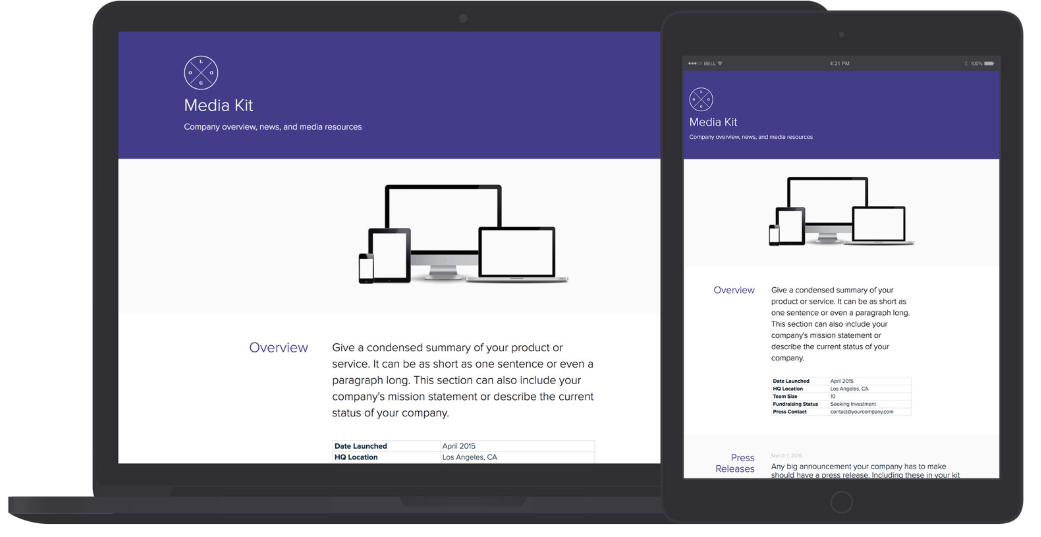
Media Kit Example, Xtensio
By this time, there are micro-conversations about your launch happening across different targeted communities as a result of your intent-based marketing activities. Creating a media kit and sending press releases to media that might be interested in your launch is essential.
It’ll help you leverage this micro-conversations, combine them, and turn them into a mass-conversation that’s forming a solid audience for your launch. Furthermore, articles in well-established media will strengthen your brand’s image and help increase customers trust towards the company.
Test with Target Market
It’s always helpful to involve the people who’re going to be using your product or service in the testing as well. The importance is to work with a select few, potential customers who look like key accounts, long-term brand lovers, and established experts.
They will give you a clear understanding of what needs polishing, what are your key selling points and some possible insights into how you can market and develop your product. This exercise is especially helpful for short-term fixes and reworks of negative features.
Drop an Intent-Fueled Bomb
The time for your launch is here. Email subscribers, post, write and publish articles, use push notifications and everything at your disposal to announce the launch is official.
Reach the Viral Point
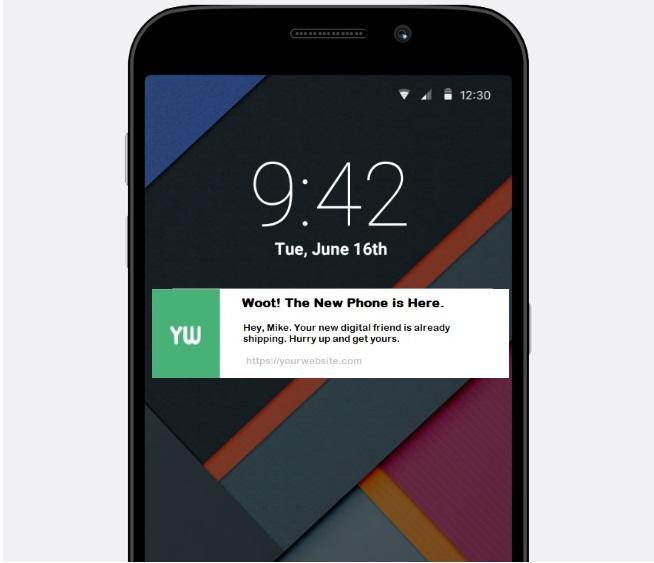
Leverage the anticipation you’ve built and watch how the engagement of your audience and starts spreading. To do this, add a viral element that would make people engage with the brand even more after they purchase. Stimulate them to share the experience with potential clients. Include personalized gifts or steps in the process that make the audience feel appreciated and want to share the excitement with others.
It’s important to think of the tone of your content. Make everyone who’s not involved feel like they’re missing on something big. In an intent-based marketing environment, you want to stimulate your leads to come to you. Invite influencers to the launch event to make them share it with their communities. Engage your audience, so they share the hype that makes their social connections want to be part of the community you’ve built.
The Golden Purchase Experience
A crucial point that many companies neglect is the fact that no matter how good of a product you have if you don’t ensure flawless purchase experience – you won’t be able to convert well enough.
You have to give your clients fast and smooth service, system stability, and on-time support to ensure no user is going to have issues when purchasing from you. If you add a nice personalization, even something as simple as “Thank you for support us, John Doe” – you’ll make the audience feel appreciated and share your content.
Intent-based Marketing as an Iterative Process
It’s important to understand that, good marketers are not the people who land everything from the first try. Marketing is all about gathering information, researching user behavioral patterns, collecting feedback, analyzing this data, and helping the marketing, sales, and development teams to answer the intent of the user and drive tangible business goals.
Use Intent-based Marketing to Build Anticipation
To have a successful launch, prospects need to know about it. As marketers part of our job is to ensure that there’s interest from the target market, the development team listens to relevant customer feedback, and the sales team have sales-qualified leads (SQL) to start converting.
To do this, we have to start building anticipation and analyzing consumer data long before the launch – a process which requires a piece-at-a-time approach, precision regarding time-frames, and constant iterations that give insights polishing the overall strategy and helping you meet your goals.

